铝及铝合金化学转化膜高质量要求
铝及铝合金铬磷化技术标准
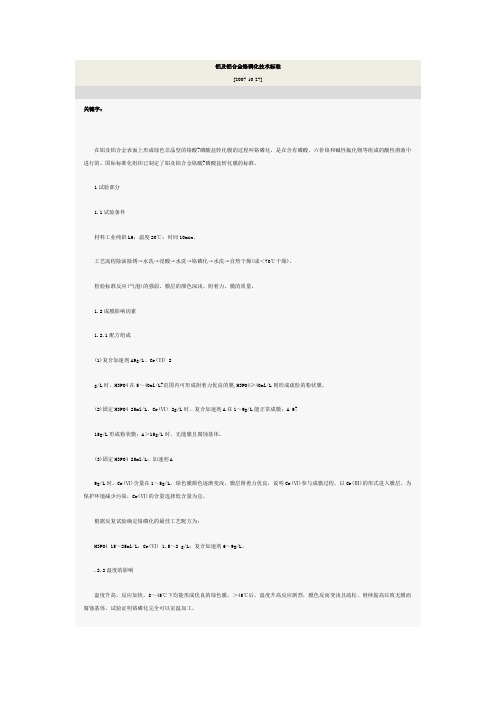
铝及铝合金铬磷化技术标准[2007-10-27]关键字:在铝及铝合金表面上形成绿色非晶型的铬酸?磷酸盐转化膜的过程叫铬磷化,是在含有磷酸、六价铬和碱性氟化物等组成的酸性溶液中进行的。
国际标准化组织已制定了铝及铝合金铬酸?磷酸盐转化膜的标准。
1试验部分1.1试验条件材料工业纯铝L6;温度20℃;时间10min。
工艺流程除油除锈→水洗→浸酸→水洗→铬磷化→水洗→自然干燥(或<70℃干燥)。
检验标准反应(气泡)的强弱、膜层的颜色深浅、附着力、膜的质量。
1.2成膜影响因素1.2.1配方组成(1)复合加速剂A9g/L、Cr(Ⅵ) 2g/L时,H3PO4在5~40ml/L?范围内可形成附着力优良的膜,H3PO4≥40ml/L则形成疏松的粉状膜。
(2)固定H3PO4 25ml/L、Cr(Ⅵ) 2g/L时,复合加速剂A在1~9g/L能正常成膜;A 9?15g/L形成粉状膜;A>15g/L时,无能膜且腐蚀基体。
(3)固定H3PO4 25ml/L:加速剂A9g/L时,Cr(Ⅵ)含量在1~5g/L,绿色膜颜色逐渐变浅,膜层附着力优良,说明Cr(Ⅵ)参与成膜过程,以Cr(Ⅲ)的形式进入膜层。
为保护环境减少污染,Cr(Ⅵ)的含量选择低含量为宜。
根据反复试验确定铬磷化的最佳工艺配方为:H3PO4 15~25ml/L;Cr(Ⅵ) 1.5~2 g/L;复合加速剂6~9g/L。
.2.2温度的影响温度升高,反应加快,8~45℃下均能形成优良的绿色膜,>45℃后,温度升高反应剧烈,膜色反而变浅且疏松,继续提高以致无膜而腐蚀基体。
试验证明铬磷化完全可以室温加工。
1.2.3时间的影响膜重与处理时间的关系。
t≤5min形成彩虹色膜,t>5min形成浅绿色膜并随时间延长绿色加深,25~35min形成深绿色膜。
当时间延长至数小时,膜层粗糙疏松。
1.2.4基材的适应性铬磷化对铝及铝合金材料的加工适应性很广泛,对工业纯铝、防锈铝、硬铝以及铸造铝合金(硅铝合金)等,都具有基体相同的成膜规律,零件表面的光泽颜色及粗糙度等仅对膜的光泽和颜色略有影响。
铝及铝合金的化学转化膜处理

铝及铝合金的化学转化膜处理
铝及铝合金的化学转化膜处理是一种表面处理技术,主要通过化学反应在铝及铝合金表面形成一层转化膜。
这层膜的外观和性质类似于金属的氧化物或氢氧化物,可以显著提高金属的耐腐蚀性和耐磨性,同时还可以赋予金属其他特殊性能,如绝缘性、导热性、美观性等。
化学转化膜处理的过程通常包括以下几个步骤:
前处理:这一步主要是清洁金属表面,去除油污、锈迹、杂质等,以保证转化膜的附着力和均匀性。
常用的清洁方法有机械法、化学法和电化学法等。
转化处理:在清洁的金属表面放入特定的化学溶液中,通过化学反应在表面形成一层转化膜。
这个过程通常需要一定的温度和时间,以促进化学反应的进行。
后处理:转化处理完成后,需要对金属表面进行清洗和干燥,以保证转化膜的质量和稳定性。
铝及铝合金的化学转化膜处理有多种类型,其中最为常见的是阳极氧化和化学氧化。
阳极氧化是一种通过外加电流使铝或铝合金表面的氧化膜增厚的方法,生成的氧化膜厚度可达数十至数百微米。
化学氧化则是通过化学反应在铝或铝合金表面形成一层氧化膜,通常生成的氧化膜较薄,约为0.5至4微米。
总之,铝及铝合金的化学转化膜处理是一种有效的表面处理技术,可以显著提高金属的耐腐蚀性和耐磨性,同时还可以赋予金属其他特殊性能。
这种处理方法广泛应用于航空、汽车、建筑、家电等领域。
6063_铝合金中性无铬转化膜制备及膜层性能分析
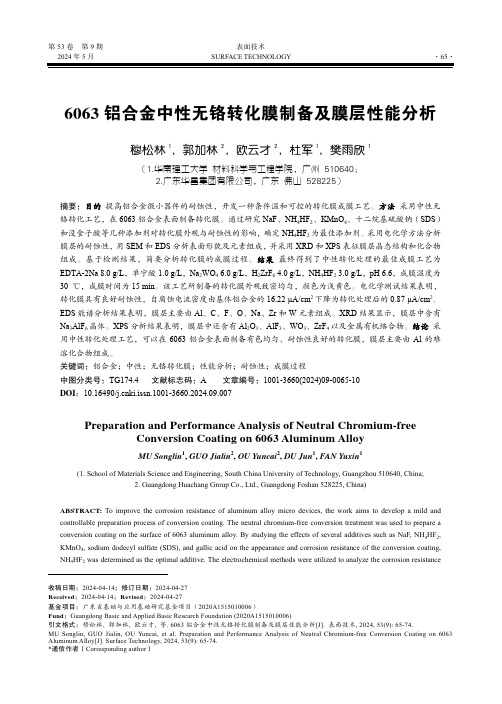
第53卷第9期表面技术2024年5月SURFACE TECHNOLOGY·65·6063铝合金中性无铬转化膜制备及膜层性能分析穆松林1,郭加林2,欧云才2,杜军1,樊雨欣1(1.华南理工大学 材料科学与工程学院,广州 510640;2.广东华昌集团有限公司,广东 佛山 528225)摘要:目的提高铝合金微小器件的耐蚀性,开发一种条件温和可控的转化膜成膜工艺。
方法采用中性无铬转化工艺,在6063铝合金表面制备转化膜。
通过研究NaF、NH4HF2、KMnO4、十二烷基硫酸钠(SDS)和没食子酸等几种添加剂对转化膜外观与耐蚀性的影响,确定NH4HF2为最佳添加剂。
采用电化学方法分析膜层的耐蚀性,用SEM和EDS分析表面形貌及元素组成,并采用XRD和XPS表征膜层晶态结构和化合物组成。
基于检测结果,简要分析转化膜的成膜过程。
结果最终得到了中性转化处理的最佳成膜工艺为EDTA-2Na 8.0 g/L,单宁酸1.0 g/L,Na2WO4 6.0 g/L,H2ZrF6 4.0 g/L,NH4HF2 3.0 g/L,pH 6.6,成膜温度为30 ℃,成膜时间为15 min。
该工艺所制备的转化膜外观致密均匀,颜色为浅黄色。
电化学测试结果表明,转化膜具有良好耐蚀性,自腐蚀电流密度由基体铝合金的16.22 µA/cm2下降为转化处理后的0.87 µA/cm2。
EDS能谱分析结果表明,膜层主要由Al、C、F、O、Na、Zr和W元素组成。
XRD结果显示,膜层中含有Na3AlF6晶体。
XPS分析结果表明,膜层中还含有Al2O3、AlF3、WO3、ZrF4以及金属有机络合物。
结论采用中性转化处理工艺,可以在6063铝合金表面制备有色均匀、耐蚀性良好的转化膜,膜层主要由Al的难溶化合物组成。
关键词:铝合金;中性;无铬转化膜;性能分析;耐蚀性;成膜过程中图分类号:TG174.4 文献标志码:A 文章编号:1001-3660(2024)09-0065-10DOI:10.16490/ki.issn.1001-3660.2024.09.007Preparation and Performance Analysis of Neutral Chromium-freeConversion Coating on 6063 Aluminum AlloyMU Songlin1, GUO Jialin2, OU Yuncai2, DU Jun1, FAN Yuxin1(1. School of Materials Science and Engineering, South China University of Technology, Guangzhou 510640, China;2. Guangdong Huachang Group Co., Ltd., Guangdong Foshan 528225, China)ABSTRACT: To improve the corrosion resistance of aluminum alloy micro devices, the work aims to develop a mild and controllable preparation process of conversion coating. The neutral chromium-free conversion treatment was used to prepare a conversion coating on the surface of 6063 aluminum alloy. By studying the effects of several additives such as NaF, NH4HF2, KMnO4, sodium dodecyl sulfate (SDS), and gallic acid on the appearance and corrosion resistance of the conversion coating, NH4HF2 was determined as the optimal additive. The electrochemical methods were utilized to analyze the corrosion resistance收稿日期:2024-04-14;修订日期:2024-04-27Received:2024-04-14;Revised:2024-04-27基金项目:广东省基础与应用基础研究基金项目(2020A1515010006)Fund:Guangdong Basic and Applied Basic Research Foundation (2020A1515010006)引文格式:穆松林, 郭加林, 欧云才, 等. 6063铝合金中性无铬转化膜制备及膜层性能分析[J]. 表面技术, 2024, 53(9): 65-74.MU Songlin, GUO Jialin, OU Yuncai, et al. Preparation and Performance Analysis of Neutral Chromium-free Conversion Coating on 6063 Aluminum Alloy[J]. Surface Technology, 2024, 53(9): 65-74.*通信作者(Corresponding author)·66·表面技术 2024年5月of the coating, SEM and EDS were applied to analyze the surface morphology and elemental composition, and XRD and XPS were used to characterize the crystalline structure and compound composition of the coating. The optimal coating-forming process for the neutral conversion treatment was obtained as: EDTA-2Na 8.0 g/L, tannic acid 1.0 g/L, Na2WO4 6.0 g/L, H2ZrF64.0 g/L, NH4HF2 3.0 g/L, pH 6.6 and treatment at 30 ℃for 15 minutes. The conversion coating prepared by the process ownedthe dense and uniform appearance in light yellow. The electrochemical test results showed that the conversion coating had good corrosion resistance, and the self-corrosion current density decreased from 16.22 µA/cm2 of the bare aluminum alloy to0.87 µA/cm2 after conversion treatment. EDS spectroscopy analysis indicated that the coating was mainly composed of Al, C, F,O, and Na elements. The XRD results illustrated that the conversion coating contained Na3AlF6 compound crystals. The XPS analysis exhibited that the coating also contained Al2O3, AlF3, and organic complexes. The formation of the conversion coating might be triggered by the dissolution of aluminum element in the conversion solution. Due to the presence of Fe and Cu elements in 6063 aluminum alloy, the difference of standard electrode potential between these metallic elements and Al, enabled them to form corrosive micro batteries in electrolyte solution. Therefore, Al element was oxidized to Al3+, while the conversion solution contained both Na+ and F–, which could react together with Al3+ to form insoluble Na3AlF6 cryolite and could be deposited on the surface of the aluminum substrate. EDS analysis showed that in the early stage of coating formation, the content of F element in the precipitated particles was 7.88at.% and Na element was 2.01at.%, and the F/Na ratio was greater than 2:1 in Na3AlF6, indicating the presence of other forms of F-containing compound. Based on the result of XPS and the types of ions in the solution, it could be concluded that the F- reacted with Al3+ to form AlF3. The ionization of ZrF62– was multi-stage process, so the concentration of free Zr4+ in the solution might be extremely low, resulting in very few Zr containing complexes.In addition, organic complexes had high steric hindrance and slow deposition. The Zr element detected in the coating might be introduced by adsorption on Na3AlF6 and AlF3 during the course of precipitation. By the neutral conversion treatment, a uniformly colored and corrosion-resistant conversion coating could be prepared on the surface of 6063 aluminum alloy, which was mainly composed of insoluble compounds of aluminum. The neutral chromium-free conversion process in this study can provide some reference for the research on conversion coatings.KEY WORDS: aluminum alloy; neutral; chrome-free conversion coating; performance analysis; corrosion resistance; coating- forming process铝合金因其具有优良的综合性能,在汽车、轨道交通、建筑型材、电子产品等领域都得到了广泛应用,是目前使用量最大、应用面最广的有色金属材料[1-5]。
铝合金表面化学转化膜制备技术的研究进展为的课题介绍

铝合金表面化学转化膜制备技术的研究进展为的课题介绍摘要本文对铝合金表面化学转化膜制备技术的研究进展进行了综述。
首先介绍了铝合金的应用领域和表面处理的重要性,然后详细讨论了不同制备方法对表面化学转化膜的形成和性能的影响,并总结了其特点和优势。
接着,重点介绍了几种常用的表面化学转化膜制备技术,包括阳极氧化、化学转化法、浸渍法和溶胶-凝胶法,并对它们的原理、工艺条件和应用进行了详细描述。
最后,展望了未来铝合金表面化学转化膜制备技术的发展方向和应用前景。
1.引言铝合金是一种重要的结构材料,广泛应用于航空、汽车、电子等领域。
然而,由于其本身的易氧化性和低耐蚀性,铝合金在使用过程中容易受到氧化、腐蚀等损害,降低了其性能和寿命。
为了增强铝合金的耐蚀性和耐磨性,改善其表面性能成为了一个重要的研究方向。
化学转化膜作为一种有效的表面处理方法,可以形成均匀、致密、具有一定厚度的膜层,能够提高铝合金的耐蚀性、耐磨性和附着力。
2.表面化学转化膜的形成和性能影响因素表面化学转化膜的形成和性能受多种因素影响,包括铝合金种类、表面处理方法、处理液组成、处理参数等。
不同的因素会对膜层的形貌、成分、厚度和性能产生不同的影响。
在制备工艺上,需要考虑溶液浓度、处理时间、温度等因素。
通过优化制备工艺条件,可以得到具有良好性能的表面化学转化膜。
3.阳极氧化法阳极氧化是一种常用的表面化学转化膜制备技术。
它通过电解处理,在阳极上形成氧化膜。
这种方法制备的膜层致密、均匀,可以提高铝合金表面的耐蚀性和耐磨性。
本节主要介绍了阳极氧化的原理、工艺步骤、工艺参数和应用。
4.化学转化法化学转化法是一种在化学反应条件下形成膜层的表面处理方法。
通过在特定的处理液中浸泡铝合金,可以使其产生化学反应,形成具有一定厚度的膜层。
本节介绍了几种常用的化学转化法,包括硫酸法、硫酸铝法和磷酸法,并分析了它们的原理、工艺条件和应用。
5.浸渍法浸渍法是一种简单、易行的表面化学转化膜制备技术。
铝合金表面处理的方法及应用

铝合金表面处理的方法及应用对铝及其合金进行表面处理产生的氧化膜具有装饰效果、防护性能和特殊功能,可以改善铝及其合金导电、导热、耐磨、耐腐蚀以及光学性能等。
因此,国内外研究人员运用各种方法对其进行表面处理,以提高它的综合性能,并取得了很大进展。
目前,铝及其合金材料已广泛地应用于建筑、航空和军事等领域中。
本文分类论述了铝及其合金材料表面处理的主要方法。
1·化学转化膜处理金属表面处理工业中的化学转化处理时使金属与特定的腐蚀液接触,在一定条件下,金属表面的外层原子核腐蚀液中的离子发生化学或电化学反应,在金属表面形成一层附着力良好的难溶的腐蚀生成物膜层。
换言之,化学转化处理是一种通过除去金属表面自然形成的氧化膜而在其表面代之以一层防腐性能更好、与有机涂层结合力更佳的新的氧化膜或其他化合物的技术。
1.1阳极氧化法铝的阳极氧化法是把铝作为阳极,置于硫酸等电解液中,施加阳极电压进行电解,在铝的表面形成一层致密的Al2O3膜,该膜是由致密的阻碍层和柱状结构的多孔层组成的双层结构。
阳极氧化时,氧化膜的形成过程包括膜的电化学生成和膜的化学溶解两个同时进行的过程。
当成膜速度大于溶解速度时,膜才得以形成和成长。
通过降低膜的溶解速度,可以提高膜的致密度。
氧化膜的性能是由膜孔的致密度决定的。
1.1.1硬质阳极氧化铝的硬质阳极氧化是在铝进行阳极氧化时,通过适当的方法,降低膜的溶解速度,获得更厚、更致密的氧化膜。
常规的方法是低温(一般为0℃左右)和低硫酸浓度(如<10%H2SO4)的条件下进行,生产过程存在能耗大、成本高的缺点。
改善硬质阳极氧化膜的另一种方法是改变电源的电流波形。
氧化膜的电阻很大,氧化过程中产生大量的热量,因此,传统直流氧化电流不宜过大,运用脉冲电流或脉冲电流与直流电流相叠加,可以极大地降低阳极氧化所需要的电压,并且可使用更高的电流密度,同时还可以通过调节占空比和峰值电压,来提高膜的生长速度,改善膜的生成质量,获得性能优良的氧化膜。
铝合金型材表面处理技术要求

铝合金型材采用阳极氧化、电泳涂漆、粉末喷涂、氟碳喷涂进行表面处理时应符合现行国家标准《铝合金建筑型材》GB/T5237规定的质量要求,表面处理层的厚度应满足下表要求铝合金型材表面处理层的厚度7.7.1阳极氧化1.阳极氧化膜的厚度级别应根据使用环境加以选择,其要求应符合下表的规定,并在合同中注明。
未注明时,门窗型材符合AA10级,幕墙型材符合AA15级。
2.氧化膜的封孔质量采用磷铬酸侵蚀重量损失法试验,失重不大于30㎎/d㎡3.阳极氧化膜的耐蚀性采用铜加速醋酸盐雾试验(CASS)和滴碱试验检测,耐磨性采用落沙试验检测,结果应符合下表规定4.氧化膜的耐候性采用313B荧光紫外灯人工加速老化试验测试,经300h连续照射后,电解着色膜色差至少应达到1级,有机着色膜色差至少应达到2级。
5.产品表面不允许有电灼伤、氧化膜脱落等影响使用的缺陷。
距型材端头80mm以内允许局部无膜或电灼伤7.7.2粉末喷涂1.喷粉型材的牌号、状态和规格,应符合GB5237.1的规定。
涂层种类为热固化饱和聚酯粉末涂层2.基材喷涂前,其表面应进行预处理,以提高基体与涂层的附着力。
化学转化膜应有一定的厚度,当采用铬化处理时,铬化转化膜的厚度应控制在200㎎/㎡~1300㎎/㎡范围内(用重量法测定)3.涂层性能1)光泽涂层的60°光泽值应于合同一致。
光泽值≥80个光泽单位的高光产品,其允许偏差不得超过±10个光泽单位,其它产品允许偏差为±7个光泽单位2)颜色和色差涂层颜色应与合同规定的标准色板基本一致。
使用仪器测定时,单色粉末的涂层与标准色板间的色差△Eab≤1.5,同一批产品之间的色差△Eab≤1.5。
3)涂层厚度装饰面上的涂层最小局部厚度≥40μm注:由于挤压型材横截面形状的复杂性,致使型材某些表面(如内角、横沟等)的涂层厚度低于规定值是允许的装饰面上涂层最大厚度≤120μm4)压痕试验涂层经压痕试验,其抗压痕性≥805)附着力涂层经划格试验其附着力应达到0级6)耐冲击性涂层整面经冲击试验后应无裂开和脱落现象,但在四面的周边允许有细小皱纹7)杯突试验结果涂层经压痕深度为6mm的杯突试验后,应无裂开和脱落的现象8)抗弯曲性涂层经曲率半径为3mm,弯曲180°后,应无开裂和脱落现象9)耐化学稳定性耐酸碱性:涂层经盐酸试验后,目视检查表面不应有气泡和其他明显变化耐溶剂性:经二甲苯试验后,涂层应无软化及其他明显变化耐灰浆性:涂层经灰浆试验后,其表面不应有脱落和其他明显变化耐盐雾腐蚀性在带有交叉划痕的试板上,经1000h乙酸盐雾试验(ASS试验)后,先对交叉划线两侧各2.0mm以外部分进行目视检查,其涂层不应有腐蚀现象。
铝及铝合金阳极氧化质量要求

a) 在盐雾试验环境中暴露168h,形成盐雾的盐水浓度为质量百分 比5%±1%,实验箱温度维持在35℃±2℃;
b) 由5个循环过程组成,每个过程包括8h暴露于饱和SO2环境(实验 箱温度维持在40℃±3℃)和16h静置于敞开的实验箱中。
封孔后的阳极氧化膜吸收能 ASTM
力损失的评估 - 酸处理后 B136
的染斑试验
3 ISO 2360
非磁性基体金属上的非导体 GB 4957
镀层 镀层厚度的测量 振幅 ASTM
敏感涡流法
B244
4 ISO 4288
产品几何量技术规范(GPS) GB 10610
表面结构:轮廓法 评定表面
结构的规则和方法
Requirements for Anodization of Aluminum and Its Alloys
范 围:
本规范规定了铝及铝合金阳极氧化的工艺要求及其质量要求。 本规范适用于铝及铝合金阳极氧化的工艺鉴定和批生产质量检验。
简 介:
本文件用于指导产品设计、生产及其产品生产过程中的质量检验; 供应商来料验收的抽检比例可按其它相关文件执行。
在每个12天的周期后,试验需经去离子水清洗。
1.5.4. 封闭质量
按ISO 2143 在试片上阳极氧化膜区域进行试验,试验后应达到 1 级或更优的等级。
1.6. 鉴定状态的保持
生产者应保持并遵守经华为技术有限公司正式批准的工艺和检验文 件。经过华为技术有限公司鉴定的工艺,在未得到华为技术有限公司的 同意之前,不能改变任何可影响性能质量的工艺参数,否则将重新进行 鉴定。
文件名称
等效标准
铝合金表面黑色化学转化工艺及膜层耐蚀性能_王爱荣-2009
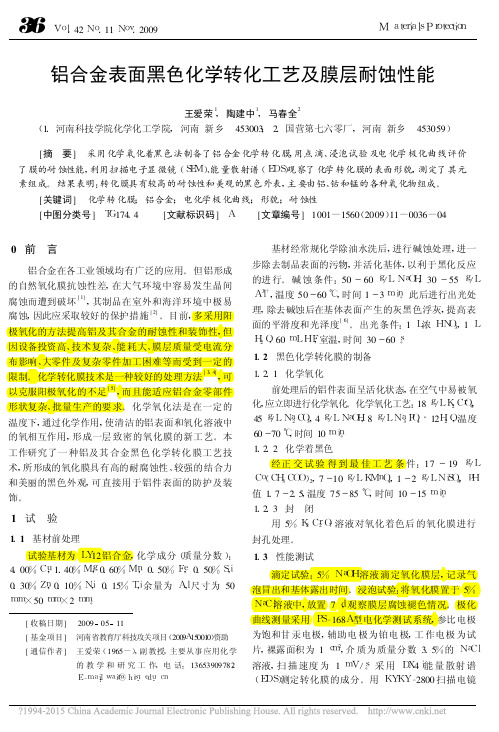
M aterialsProtection
铝合金表面黑色化学转化工艺及膜层耐蚀性能
王爱荣 1 , 陶建中1 , 马春全2 (1.河南科技学院化学化工学院 , 河南 新乡 453003;2.国营第七六零厂 , 河南 新乡 453059)
[摘 要 ] 采用化学氧化着黑色法制备了铝合金化学转化膜 , 用点滴 、浸泡试验及电化学极化曲线评价 了膜的耐蚀性能 , 利用扫描电子显微镜 (SEM)、能量散射谱 (EDS)观察了化学转化膜的表面形貌 , 测定了其元 素组成 。 结果表明 :转化膜具有较高的耐蚀性和美观的黑色外表 , 主要由铝 、钴和锰的各种氧化物组成 。
[ 6 ] GarberJD.Modelingcorrosionratesinnon-annulargas condensatewellscontaining CO2 [ A] . Corrosion 1998 [ C] .Houston:NACE, 1998:53.
[ 7 ] 刘 伟 , 陈新房 .油对常用水稳剂缓蚀阻垢和分散性能 的影响 [ J] .工业水处理 , 2006, 26(12):48 ~ 50. [ 编辑 :王 宇 ]
的 教 学 和 研 究 工 作 , 电 话 :13653909782, E-mail:wair@
基材经常规化学除油水洗后 , 进行碱蚀处理 , 进一 步除去制品表面的污物 , 并活化基体 , 以利于黑化反应 的进 行 。 碱 蚀 条件 :50 ~ 60 g/LNaOH, 30 ~ 55 g/L Al3+ , 温度 50 ~ 60 ℃, 时间 1 ~ 3 min。此后进行出光处 理 , 除去碱蚀后在基体表面产生的灰黑色浮灰 , 提高表 面的平滑度和光泽度[ 6] 。 出光条件 :1 L浓 HNO3 , 1 L H2 O, 60 mLHF, 室温 , 时间 30 ~ 60 s。
MIL-DTL-5541F铝和铝合金的化学转化膜
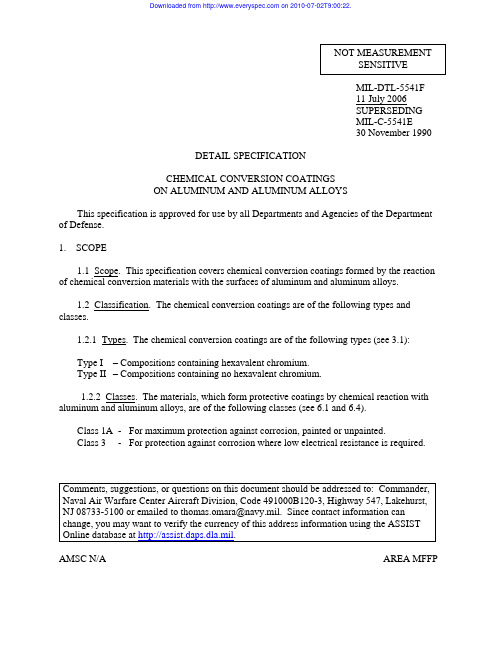
MIL-DTL-5541F11 July 2006SUPERSEDINGMIL-C-5541E30 November 1990DETAIL SPECIFICATIONCHEMICAL CONVERSION COATINGSON ALUMINUM AND ALUMINUM ALLOYSThis specification is approved for use by all Departments and Agencies of the Department of Defense.1. SCOPE1.1 Scope. This specification covers chemical conversion coatings formed by the reaction of chemical conversion materials with the surfaces of aluminum and aluminum alloys.1.2 Classification. The chemical conversion coatings are of the following types andclasses.1.2.1 Types. The chemical conversion coatings are of the following types (see 3.1):Type I – Compositions containing hexavalent chromium.Type II – Compositions containing no hexavalent chromium.1.2.2 Classes. The materials, which form protective coatings by chemical reaction withaluminum and aluminum alloys, are of the following classes (see 6.1 and 6.4).Class 1A - For maximum protection against corrosion, painted or unpainted.Class 3 - For protection against corrosion where low electrical resistance is required.Comments, suggestions, or questions on this document should be addressed to: Commander,Naval Air Warfare Center Aircraft Division, Code 491000B120-3, Highway 547, Lakehurst,NJ 08733-5100 or emailed to thomas.omara@. Since contact information canchange, you may want to verify the currency of this address information using the ASSISTOnline database at .AMSC N/A AREA MFFP2. APPLICABLE DOCUMENTS2.1 General. The documents listed in this section are specified in sections 3 or 4 of this specification. This section does not include documents cited in other sections of this specification or recommended for additional information or as examples. While every effort has been made to ensure the completeness of this list, document users are cautioned that they must meet all specified requirements of documents cited in sections 3 or 4 of this specification, whether or not they are listed.2.2 Government documents.2.2.1 Specifications and standards. The following specifications and standards form a part of this document to the extent specified herein. Unless otherwise specified, the issues of these documents are those cited in the solicitation or contract.STANDARDSFEDERALFED-STD-141 - Paint, Varnish, Lacquer and Related Materials: Methods ofInspection, Sampling and TestingDEPARTMENT OF DEFENSE SPECIFICATIONSMIL-PRF-23377 - Primer Coatings: Epoxy, High-SolidsMaterials for Coating Aluminum andConversionMIL-DTL-81706 - ChemicalAluminum AlloysMIL-PRF-85582 - Primer Coatings: Epoxy, Waterborne(Copies of these documents are available online at /quicksearch or or from the Standardization Document Order Desk, 700 Robbins Avenue, Building 4D, Philadelphia, PA 19111-5094.)2.3 Non-Government publications. The following documents form a part of this document to the extent specified herein. Unless otherwise specified, the issues of these documents are those cited in the solicitation or contract.AMERICAN SOCIETY FOR TESTING AND MATERIALS (ASTM) INTERNATIONALASTM-B117 - Salt Spray (Fog) Apparatus, Operating. (DoD adopted)ASTM-D3359 - Adhesion By Tape Test, Measuring. (DoD adopted)(Copies of these documents are available from ASTM International, 100 Barr Harbor Drive, West Conshohocken, PA 19428-2959 or .).AMERICAN SOCIETY FOR QUALITY (ASQ)ASQ-Z1.4 - Procedures, Sampling and Tables for InspectionAttributesby(Copies of this document are available from American Society for Quality, 600 North Plankinton Ave., Milwaukee, WI 53203 or .)SOCIETY OF AUTOMOTIVE ENGINEERS (SAE) INTERNATIONALSheet and Plate, 1.0Mg-0.60Si-0.28Cu-Alloy,SAE-AMS4027 - Aluminum0.20Cr, (6061; -T6 Sheet, -T651 Plate) Solution andPrecipitation Heat Treated. (DoD adopted)SAE-AMS4037 - Aluminum Alloy, Sheet and Plate, 4.4Cu-1.5Mg-0.60Mn,(2024; -T3 Flat Sheet; -T351 Plate) Solution Heat Treated.(DoD adopted)(Copies of these documents are available from SAE International, 400 Commonwealth Drive, Warrendale, PA 15096-0001 or .)2.4 Order of precedence. In the event of a conflict between the text of this document and the references cited herein, the text of this document takes precedence. Nothing in this document, however, supersedes applicable laws and regulations unless a specific exemption has been obtained.3. REQUIREMENTS3.1 Materials. If no material type is specified type I shall be used. Unless otherwise specified in the contract or order, substitutions of either type I for type II, or type II for type I coatings are not permitted. The materials used to produce a chemical conversion coating shall be approved for the selected type, class, form, and application method in accordance with the qualification requirements of MIL-DTL-81706 and shall have been accepted for listing on the applicable qualified products list (see 6.5). Replenishing chemicals, such as fluorides, added to a bath to maintain its efficiency, shall not degrade the performance of the coating being applied.3.2 Cleaning. Prior to coating, the base metal shall be mechanically or chemically cleaned such that a water break-free surface is obtained after rinsing (see 6.6). Abrasives containing iron such as steel wool, iron oxide, rouge, or steel wire are prohibited for all cleaning operations. Treated parts that have become soiled shall be cleaned with materials that will remove the soil without damaging the base metal, the part, or the conversion coating. If the coating is damaged, the damaged area shall be recleaned and recoated or the part shall be rejected.3.3Application. Unless an application method is specified in the contract or order(see 6.4), the chemical conversion coating shall be applied nonelectrolytically by spray, brush, or immersion after all heat treatments and mechanical operations such as forming, perforating, machining, brazing, and welding have been completed (see 6.11 and 6.14). Assemblies containing nonaluminum parts that may be attacked, embrittled, or damaged in any way by the conversion coating process shall not be coated as assemblies unless the nonaluminum parts are masked.3.4 Touch-up. If specified in the contract or order, mechanically damaged areas from which the coating has been removed shall be touched up or rejected. The damaged areas shall be touched up with MIL-DTL-81706 material approved on QPL-81706 for the applicable type, class, form, and method. The area to be touched up shall be not greater than 5 percent of the total item surface area (see 6.4 and 6.17).3.5 Appearance. The chemical conversion coating shall be continuous in appearance and visibly discernible in daylight. It shall be free from areas of powdery or loose coating, voids, scratches, flaws, and other defects or damages which reduce the serviceability of parts or are detrimental to the protective value and paint bonding characteristics. The size and number of contact marks shall be minimal, consistent with good practice. If specified in the contract or order, contact marks shall be touched up with MIL-DTL-81706 material approved on QPL-81706 for the applicable type, class, form, and method to prevent localized corrosion (see 6.4 and 6.8).3.6 Performance characteristics.3.6.1 Corrosion resistance. At the end of 168 hours of exposure to the 5 percent salt spray test specified in4.4.1, test specimens (see 4.2.2) treated with the applicable class of coating shall meet the following corrosion resistance requirements (see 6.14):a.No more than 5 isolated spots or pits (see 6.9), none larger than 0.031 inch in diameter,per test specimen. Areas within 0.25 inch from the edges, identification markings, andholding points during processing or salt spray exposure shall be excluded. Loss of color shall not be cause for rejection.b.No more than 15 isolated spots or pits, none larger than 0.031 inch in diameter, on thecombined surface area of all five test specimens, subjected to the salt spray test.3.6.2 Paint adhesion (wet tape). When the production paint system (6.13) or the paint system specified in4.2.2.1.1 is applied to the applicable test specimens (see 4.2.2), no intercoat separation shall occur between the paint system and the conversion coating, or between the conversion coating and the base metal, when tested in accordance with 4.4.2 (an adhesion rating of 4A or better according to ASTM-D3359 Procedure A) (see 6.12). If the conversion coated parts do not require painting for end use, the paint adhesion test may be omitted if specifically authorized by the acquisition activity (see 6.4).3.7 Electrical contact resistance of class 3 coatings. Electrical contact resistance testingshall be as specified in the contract or order (see 6.4). The test method, frequency of testing, and required resistance values shall be specified by the acquisition activity to meet the needs of aparticular application (see 6.1.2.1).3.8 Chemical analysis of the conversion solution. Chemical analysis of the conversionsolution shall consist of concentration, pH, and temperature evaluations to determine that thebath is within the ranges specified by the chemical manufacturer (see 6.11).3.9 Workmanship. The chemical conversion coatings covered by this specification shall be produced by treatments and processes that produce coated components as specified in thisspecification.4. VERIFICATION4.1 Classification of inspections. The inspection requirements specified herein areclassified as follows:a. Process control inspection (see 4.2).b. Conformance inspection (see 4.3).4.2 Process control inspection.4.2.1 Process control tests and solution analysis. Test specimens shall be tested inaccordance with table I and 4.2.1.1. In addition to the tests in table I, solution analysis shall be performed on all the processing solutions in the chemical conversion line (see 3.8) to verify that the chemical concentrations are within ranges established for optimum performance (see 6.11and 6.14). Process control tests are conducted to determine compliance of the chemicalconversion coatings with the requirements of this specification and are acceptable as evidence of the properties being obtained with the equipment and procedures employed.TABLE I. Process control tests. Tests Class Number of test specimens Test specimen preparationparagraphRequirement paragraph TestparagraphCorrosion resistance 1A 3 5 5 4.2.2 4.2.2 3.6.1 3.6.1 4.4.14.4.1Wet tape adhesion 1A 3 2 2 4.2.2-4.2.2.14.2.2-4.2.2.1 3.6.2 3.6.2 4.4.24.4.2Electrical contactresistance3 5 4.2.2 3.7 4.4.14.2.1.1 Frequency of process control testing and solution analysis. Solution analysis shall at a minimum be performed once every week (see 6.15). The process control tests specified in table I shall at a minimum be conducted on a monthly basis. In addition, the interval between each monthly test shall not exceed 35 days. If production in accordance with this specification is not performed for 35 days or more, process control tests and solution analysis shall be conducted at the restart of production.4.2.2 Process control test specimens. Test specimens used for process control testing shall be 3 inches wide, 10 inches long, with a nominal thickness of not less than 0.020-inch.The test specimens shall be processed with the hardware during an actual production run, including all pre- and post-treatment processes such as cleaning and rinsing, except as specified below. Unless otherwise specified in the contract or order (see 6.4), either of the following alloy options for the process control test specimens shall be used:Option 1 - A set of test specimens shall be used for each alloy and temper treated during the monthly process control period.Option 2 - The test specimens shall be 2024-T3 aluminum alloy in accordance withSAE-AMS4037 for class 1A coatings and 6061-T6 aluminum alloy test specimens in accordance with SAE-AMS4027 for class 3 coatings. Aluminum alloy 2024-T3 test specimens may be used in lieu of 6061-T6 test specimens for testing class 3 coatings (see 6.10). When castings are being processed and the cleaning procedures used are detrimental to the wrought test specimens, the test specimens shall be cleaned in a proper manner (see 3.2) and the conversion coated with the castings. If the production parts are not 2024-T3 aluminum alloy and the etch or deoxidizer may be detrimental to the test specimens, the manufacturer’s recommended cleaning practices shall be used.4.2.2.1 Preparation of paint adhesion specimens. Unless otherwise specified on the contract or order (see 6.4), the paint system to be used on the test specimens for adhesion testing (see4.4.2 and 6.13) shall be the same system used for the production work (applied and cured in the same manner as the production work) or the paint system specified in 4.2.2.1.1.4.2.2.1.1 Epoxy primer coatings. Test specimens shall be furnished with one coat of a volatile organic compound (VOC) compliant epoxy-polymide primer conforming toMIL-PRF-23377 or MIL-PRF-85582. In either case, the primer shall be applied to a dry film thickness of 0.0006 to 0.0009 inch (0.6 to 0.9 mil) and dried in accordance with the applicable primer specification before testing in accordance with 4.4.2.4.2.3 Failure. Failure to conform to any of the process control requirements specified in table I shall result in immediate cessation of production. The reason for failure shall be determined and corrected before production resumes. All traceable and retrievable work from the last acceptable process control test to the time when the failure was determined shall be rejected, unless the work under review can be demonstrated to meet the requirements of thisspecification. Unless otherwise specified, parts that have been painted or incorporated into an assembly shall not be considered retrievable.4.3 Conformance inspection.4.3.1 Sampling. Samples for visual examinations shall be selected from each lot (see 4.3.2) of treated articles, items, parts, or components. Unless otherwise specified in the contract or order (see 6.4 and 6.18), the sampling plan and acceptance criteria shall be as specified in ASQ-Z1.4, inspection level II.4.3.2 Visual lot examination. Samples selected in accordance with 4.3.1 shall be visually inspected for compliance with 3.5 and 3.9. Each lot shall be inspected to ensure that the lot consists of all conversion coated items of the same type, class, form, and method, treated under the same process conditions, and submitted for acceptance at one time. Unless otherwise specified on the contract or order, the lot size shall not exceed the number of parts, articles, items, or components resulting from one day’s production (see 6.4).4.3.3 Failure. Failure to conform to 4.3.2 shall result in rejection of the represented lot.4.4.Test methods.4.4.1 Corrosion resistance test. Five test specimens prepared in accordance with 4.2.2 shall be used for corrosion resistance testing. After the coating application, the test specimens shall be dried at 60 to 100 ºF (16 to 38 ºC) for 24 hours (see 6.14). The test specimens shall then be subjected to a 5 percent salt spray test in accordance with ASTM-B117 for 168 hours, except that the significant surface shall be inclined 6 ± 2 degrees from the vertical. After exposure, test pieces shall be cleaned in running water not warmer than 100 ºF (38 ºC), blown with clean, dry unheated air, and visually examined for conformance to 3.6.1. The dry unheated air for type I shall be not warmer than 100 ºF (38 ºC) and for type II shall follow the manufacturer’s recommended temperature ranges.4.4.2 Wet tape adhesion test. Two test specimens prepared in accordance with 4.2.2 and 4.2.2.1 shall be tested for wet tape adhesion. The test shall be conducted in accordance with FED-STD-141, method 6301, to determine conformance to 3.6.2.5. PACKAGING5.1 Not applicable.6. NOTES(This section contains information of a general or explanatory nature that may be helpful, but is not mandatory.)6.1 Intended use. The conversion coatings covered by this specification are intended for use, throughout the Department of Defense, on aluminum and aluminum alloy substrates that are not anodized. They are used to repair anodized coatings on aluminum. They are designated as a post treatment to ion-vapor deposition (IVD) aluminum used on many military platforms as a cadmium alternative or galvanic corrosion inhibitor. Type I and II conversion coatings provide corrosion protection on unpainted items, as well as improve adhesion of paint finish systems on aluminum and aluminum alloys. The conversion coatings covered by this specification exceed commercially available products due to the nature of their use on aircraft.6.1.1 Class 1A. Class 1A chemical conversion coatings are intended to provide corrosion prevention on unpainted items as well as improve adhesion of paint finish systems on aluminum and aluminum alloys. Coatings of this type may be used, for example, on tanks, tubing, and component structures where paint finishes are not required for interior surfaces but are required for the exterior surfaces.6.1.2 Class 3. Class 3 chemical conversion coatings are intended for use as a corrosion preventive film for electrical and electronic applications where lower resistant contacts, relative to class 1A coatings, and anodic coatings in accordance with MIL-A-8625, are required (see 6.1.2.1). Coating thickness is varied by immersion time, and as a result, the same conversion material can be listed on QPL-81706 for both classes. Because class 3 coatings are thinner they are more susceptible to corrosion than class 1A coatings. If it is required to paint areas surrounding electrical contacts, class 3 coatings improve adhesion of paint systems on aluminum and aluminum alloys.6.1.2.1 Electrical resistance testing. When under a nominal electrode pressure of 200 psi, class 3 coatings are qualified under MIL-DTL-81706 to have a resistance not greater than 5,000 microhms per square inch as supplied and 10,000 microhms per square inch after 168 hours of salt spray exposure. In addition to the coating or coating thickness (see 6.1.2), other variables heavily influence resistance values when using the test method specified in MIL-DTL-81706 or other similar methods. The following two variables (see 6.1.2.1.1 and 6.1.2.1.2) may have a greater effect on electrical resistance values than the conversion coating thickness.6.1.2.1.1 Surface roughness of the specimen panel. Test specimens having rough surfaces will yield lower resistance values when subjected to a contact electrode pressure due to coating fracture. This reasoning can also be applied to the contact electrode.6.1.2.1.2 Flatness of the contact electrode. If an electrode with a given surface area is not flat, the actual contact area will be lower than the theoretical value. A smaller contact arearesults in a higher resistance value. The same reasoning can be applied to the test specimen.6.2 Responsibility for inspection. Unless otherwise specified in the contract or order, the contractor is responsible for the performance of all inspection requirements (examinations and tests) as specified herein. Except as otherwise specified in the contract or order, the contractor may use his own or any other facilities suitable for the performance of the inspection requirements specified herein, unless disapproved by the Government. The Government reserves the right to perform any of the inspections set forth in the specification where such inspections are deemed necessary to ensure supplies and services conform to prescribed requirements.6.3 Responsibility for compliance. All items must meet the requirements of section 3. The inspection set forth in this specification must become a part of the contractor’s overall inspection system or quality program. The absence of any inspection requirement in the specification will not relieve the contractor of the responsibility of ensuring that all products or supplies submitted to the Government for acceptance comply with all requirements of the contract. Sampling inspection, as part of manufacturing operations, is an acceptable practice to ascertain conformance to requirements, however, this does not authorize submission of known defective material, either indicated or actual, nor does it commit the Government to acceptance of defective material.6.4 Acquisition requirements. Acquisition documents should specify the following:a. Title, number, and date of the specification.b. Type and class required (see 1.2.1 and 1.2.2).c.Method of application, if restricted (see 3.3).d. If touch-up is permitted for mechanically damaged areas (see 3.4).e.Colorless coatings, if required (see 3.5).f. If touch-up is permitted for contact marks (see 3.5)g.Omit the paint adhesion test, if permitted (see 3.6.2).h.If electrical resistance testing if required for class 3 coatings (see 3.7 and 6.1.2).i.When electrical resistance testing is required, specify the required resistance values,frequency of testing, and test method (see 3.7 and 6.1.2).j.Alloy and temper of the process control test specimens, if different than that specified in4.2.2.k.Paint finish system for treated parts, if applicable (see 4.2.2.1).l.Quantity required.m. Sampling plan, if different than that specified (see 4.3.1 and 6.18).n. Lot size, if different than that specified (see 4.3.2).6.5 Interchangeability. The various products approved in accordance withMIL-DTL-81706 and listed on QPL-81706 provide equivalent coatings within eachtype and class. These coatings are equivalent insofar as performance of the chemical conversion coating is concerned, to the provisions of this specification, but are not interchangeable from a chemical standpoint; that is, different materials cannot be mixed. The materials from onesupplier cannot be mixed or used to strengthen an existing solution from another material supplier. As the chemical coating materials are proprietary products, the ingredients, processes, the method of application (e.g., spray, brush, or immersion), and the equipment required for application of the coating may vary. Contractors and military activities must take this into account in acquisition, in the design of parts, and in the establishment of facilities. Detail drawing of parts requiring treatment in accordance with this specification should specify class1A or 3, where applicable the required type, I or II, and any paint finishing systems required to meet the performance desired. If the coating class is not specified, class 1A is recommended.6.6 Cleaners. Use of a non-etch cleaner is preferred, particularly on wrought alloys. If an etch is used, caution must be taken to prevent pitting or intergranular attack. This is particularly important when using an alkaline etch because the aluminum tends to be more soluble than its alloying elements and existing intermetallics, such as copper, which may be further exposed. As a result, alkaline etching should be avoided (particularly when cleaning assembled structures). If an alkaline etch is used, it should always be followed by an acid neutralization step.6.7 Abrasion resistance. The abrasion resistance of chemical coatings is relatively low. Coatings are reasonably durable when subjected only to moderate handling, but are readily removed by severe wear or erosion. However, cold forming operations, when performed with care, can generally be performed on treated metals without appreciable damage to the coatings.6.8 Visual appearance. The simplest way to evaluate a conversion coating is to observe color, continuity in appearance, smoothness and adhesion to the base metal (see 3.5). Visual examination is performed to ensure that proper cleaning and coating procedures were used such that a coating with sufficient protection exists over the entire part. Materials qualified underMIL-DTL-81706 produce coatings that range in color from clear/colorless to iridescent yellow, brown, gray, or blue. It may be possible to develop acceptable color levels for a particular coating system by use of color chips. The following circumstances may exist that relate to color uniformity:a.When several alloys are processed with the same conversion chemical, color may varyfrom alloy to alloy.b.Due to the high level of impurities and oxidation on the surfaces of aluminum welds andcastings, color may not be as uniform as that obtained by treating wrought alloys.c.Dark spots may result from dripping or rundown of the conversion chemicals when theparts are lifted out of the treatment tank. A small amount of spotting does not result incoating degradation but must be minimized by quickly rinsing the parts after treatment, and use of proper racking techniques.Visual examination does not reveal if the protective value of the coating has been impaired by contamination or by overheating during drying. If a clear coating is required, inspection difficulties may arise because visual inspection does not reveal the presence of a coating. Fortype I materials, existence of a coating can be verified by using a simple spot test specified in ASTM-B449. For type II materials, existence of a coating should be verified per the manufacturer’s recommendation6.9 Determination of a corrosion spot or pit. As a general rule, a corrosion spot or pit usually displays a characteristic tail or line, however, any visible corrosion or pitting except scratches or substrate surface defects is to be counted..6.10 Test specimens (2024-T3). Due to high copper content, 2024-T3 aluminum alloy test specimens are more susceptible to salt spray failure than 6061-T6 aluminum alloy test specimens (see 4.2.2).6.11 Chemical analysis of the conversion solution. Note that many conversion materials do not react sufficiently with aluminum surfaces at low temperatures. Conversion coating of parts in an unheated facility, such as a hangar, during colder periods of the year is not recommended.6.12 Paint adhesion. Coated parts should be allowed to dry in accordance with the chemical manufacturer’s recommendation before they are subsequently painted or adhesion failures may occur. When coated parts are stored for extensive periods before painting, they should be cleaned in accordance with 3.2 to reactivate the surface by removing dust particles. Excessively thick coatings may result in paint adhesion problems, such as blistering, due to higher amounts of soluble material under the paint.6.13 Paint compatibility. Compatibility problems between conversion coatings and certain Chemical Agent Resistant Coatings (CARC) have been reported.6.14 Temperature effects on corrosion protection. Unpainted conversion coatings will commence losing corrosion resistance properties if exposed to temperatures of 140 ºF (60 ºC) or higher, during drying, subsequent fabrication, or service. As temperatures and exposure times increase, the corrosion protection of unpainted conversion coated parts decreases. The reduction is believed to result from the coating dehydrating and the resulting insolubility of the chromates within the coating.6.15 Solution analysis documentation. Documentation of the history of each processing bath, showing additions of replenishing chemicals to the bath and the results of all solution analyses performed must be maintained. Testing of the solution should be consistent with best industry practices and manufacturer’s recommendations. Upon request of the acquisition activity, such records, as well as reports of the test results, should be made available. These records must be maintained for not less than one year after completion of the contract or order.6.16 Shelf life. This specification covers items where shelf life is a consideration. Specific shelf-life requirements should be specified in the contract or purchase order. The shelf-life codes are contained in the Federal Logistics Information System Total Item Record. Additive information for shelf-life management may be obtained from DoD 4140.27-M, Shelf-life。
铝及铝合金的电化学氧化
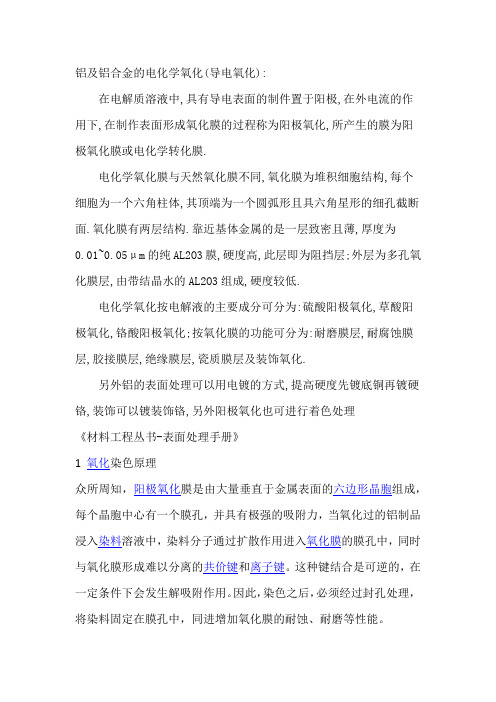
铝及铝合金的电化学氧化(导电氧化):在电解质溶液中,具有导电表面的制件置于阳极,在外电流的作用下,在制作表面形成氧化膜的过程称为阳极氧化,所产生的膜为阳极氧化膜或电化学转化膜.电化学氧化膜与天然氧化膜不同,氧化膜为堆积细胞结构,每个细胞为一个六角柱体,其顶端为一个圆弧形且具六角星形的细孔截断面.氧化膜有两层结构.靠近基体金属的是一层致密且薄,厚度为0.01~0.05μm的纯AL2O3膜,硬度高,此层即为阻挡层;外层为多孔氧化膜层,由带结晶水的AL2O3组成,硬度较低.电化学氧化按电解液的主要成分可分为:硫酸阳极氧化,草酸阳极氧化,铬酸阳极氧化;按氧化膜的功能可分为:耐磨膜层,耐腐蚀膜层,胶接膜层,绝缘膜层,瓷质膜层及装饰氧化.另外铝的表面处理可以用电镀的方式,提高硬度先镀底铜再镀硬铬,装饰可以镀装饰铬,另外阳极氧化也可进行着色处理《材料工程丛书-表面处理手册》1 氧化染色原理众所周知,阳极氧化膜是由大量垂直于金属表面的六边形晶胞组成,每个晶胞中心有一个膜孔,并具有极强的吸附力,当氧化过的铝制品浸入染料溶液中,染料分子通过扩散作用进入氧化膜的膜孔中,同时与氧化膜形成难以分离的共价键和离子键。
这种键结合是可逆的,在一定条件下会发生解吸附作用。
因此,染色之后,必须经过封孔处理,将染料固定在膜孔中,同进增加氧化膜的耐蚀、耐磨等性能。
2 阳极氧化工艺对染色的影响在氧化染色整个流程中,因为氧化工艺原因造成染色不良是比较普遍的。
氧化膜的膜厚和孔隙均匀一致是染色时获得均匀一致颜色的前提和基础,为获得均匀一致的氧化膜,保证足够的循环量,冷却量,保证良好的导电性是举足轻重的,此外就是氧化工艺的稳定性。
硫酸浓度,控制在180—200g/l。
稍高的硫酸浓度可促进氧化膜的溶解反应加快,利于孔隙的扩张,更易于染色;铝离子浓度,控制在5—15 g/l。
铝离子小于5g/l,生成的氧化膜吸附能力降低,影响上色速度,铝离子大于15g/l时,氧化膜的均匀性受到影响,容易出现不规则的膜层。
mil-dtl-5541f中文版

MIL -DTL - 5541F铝和铝合金的化学转化膜1. 范围范围。
此规格涉及通过与表面爲铝和铝合金的化学转化材料反应而组成的化学转化膜。
分类。
化学转化膜有如下类型和等级。
类型。
化学转化膜有如下类型(见:类型I—包含六价铬的组成物类型II—无六价铬的组成物等级。
通过于铝和铝合金化学反应贰组成的材料有如下等级(见和)等级1A—爲最大限度保护防止喷涂的或者未喷涂处的腐蚀、等级3—爲保护防止需低电性阻值处的腐蚀2. 适用文件大意:此部分所列文件在本说明的第三和第四部分都有详细列明。
本部分不包含此说明中其他章节所引用的文件,推荐的附加信息文件以及用作事例的文件。
爲确保此清单的完整性已作岀很多努力,文件使用者应注意,必须满足章节3或4引用文件的要求,不管这些文件有没有在此列明。
政府文件规格和标准。
以下规格和标准组成本文件的一部分。
除非特别指定,这些文件的问题引用在恳请或合同中。
联邦标准FED-STD-141---喷涂、油漆、涂漆和其他相关材料:检验、抽验和测试的方法国防部标准MIL-PRF-23377 ---涂底漆:环氧基树脂,高固形化MIL-DTL-81706---用于涂覆铝及铝合金的化学转化膜MIL-PRF-85582---涂底漆:环氧基树脂,waterborne厦700罗宾逊大街的标准文件预定服务台索取)(这些文件的副本可以在网站或者在线查看,或者也可以从位于PA19111-5094费城4D大非政府出版物。
以下规格和标准组成本文件的一部分。
除非特别指定,这些文件的问题引用在恳请或合同中。
美国材料试验协会ASTM-B117 ---- 盐雾试验仪器操作ASTM-D3359--- 胶带附着力测试(这些文件副本可以从位于PA19428-2959 ,west conshohocken, ASTM 获得或者从网站了解)美国质量协会(ASQ)ASQ-Z --- 通过属性进行程序,抽样及台板检验(此文件副本可从位于美国密尔沃基市的美国质量协会获得或从网站了解到。
国 际 标 准化学转化膜
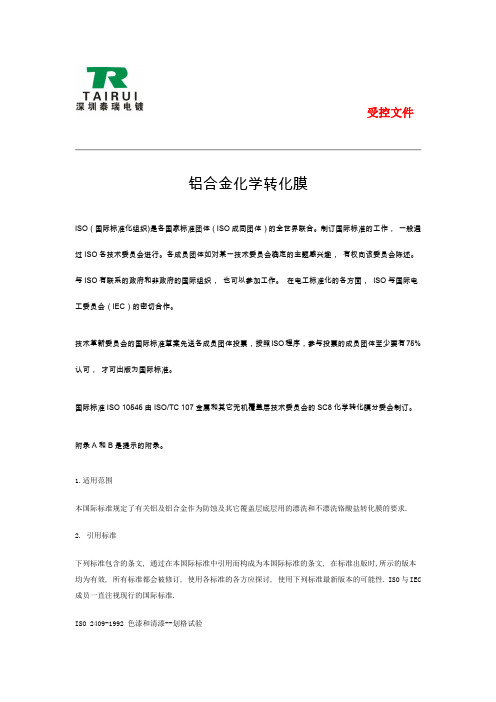
ISO 3892-1980 金属材料上的转化膜----单位面积上膜层质量的测量---重量法.ISO 4519-1980 电沉积金属覆盖层和有关精饰层---特性检查抽样程序.ISO 9227-1990 人造气氛腐蚀试验----盐雾试验.IEC 68-2-3-1969 环境试验法----第二部分: 试验----试验 Ca, 稳态湿热试验.IEC 130-1-1988 频率小于3mHz的接插件----第一部分: 一般要求和测量方法.3. 定义本国际标准采用以下定义.3.1 漂洗铬酸盐转化膜水漂洗后再干燥的铬酸盐转化膜, 典型地应用于挤压铝制件, 铸件和铝线.3.2 非漂洗铬酸盐转化膜铬酸盐处理后立即干燥而不用水漂洗的铬酸盐转化膜. 这种特殊类型的转化膜用在需要随后立即加油漆来或粘著涂层的铝基线材上, 有时称之为线材膜.4. 表面准备待铬酸盐转化处理工件的表面应清洁而无氧化皮或污物, 例如, 无金属车磨加工的切屑, 油脂, 润滑剂, 手汗或任何有害于最后精饰的的其它污物, 因此, 工件在铬酸盐转化处理前必须先清洗, 必要时还应酸洗.图B.1表示了各种工艺步骤的选择方案, 在不漂洗铬酸盐转化处理前, 表面不允许存在未反应的可溶性盐类.5. 铬酸盐转化处理方法非铝金属材料不应在同一铬酸盐处理溶液中处理, 以免原电池腐蚀.通常采用浸渍法形成铬酸转化膜, 也可以采用淹没, 喷淋,或擦涂等技术. 这些成膜技术应符合铬酸盐转化处理操作说明. 铬酸盐转化处理液一般是酸性的并含有六价铬和(或)三价铬的盐以及其它组份, 这些组份对外观和硬度的影响各异. 因而膜的色彩, 膜的类型取决于铬酸盐转化处理液的组成, 但也受溶液PH 值, 温度, 处理时间, 溶液搅拌等处理合金的特性及表面状况的影响.漂洗铬酸盐转化膜必须有最后一道水漂洗. 如果漂洗铬酸盐处理用作附加覆盖层的基底则表面应当有用电导率小于100us/cm的水漂洗, 如果铬酸盐处理后的最后一道漂洗采用热水, 则漂洗时间应尽量短, 以防六价铬溶解 . 铬酸盐转化膜的干燥温度(指工件表面测定的温度)不能超过65℃, 磷铬酸盐膜不超过85℃, 以防过度脱水.非漂洗铬酸盐转化膜的干燥应按生产厂的说明进行.若铬酸盐转化膜起著涂层底层的作用, 则涂漆前的干燥应分两步进行, 不超过65℃进行预干燥, 在100-110℃进行第二步干燥 , 以达到最好附著力.注: 1. 100-110℃的热处理影响不涂漆区的耐蚀性.6. 对膜层的技术要求6.1 一般要求.铬酸盐转化膜随著膜层的逐渐脱水老化而变硬, 因此在处理后的24小时内搬动应小心, 任何试验(包括腐蚀试验)都应在此时期之后进行.绿色磷----铬酸盐转化膜在较长时间贮存后, 达到最大的耐蚀性能, 一般是在室温条件下放1-2个月.6.2 绝缘电阻单位面积膜的质量较小的无色, 浅黄色, 浅绿的彩色铬酸盐膜, 在电连接器与铝之间的电阻值只有极小的增加. 根据IEC-130-1 标准规定的测定方法, 在开路电压为9V, 电流为2A时测出的电阻应小于0.1欧,随著膜层单位面积质量的增加, 棕色, 黄色, 绿色等深色膜的接触电阻明显增加.6.3 附著强度.膜层应附著牢固, 无粉状物, 目前还没有测量铝上铬酸盐转化膜附著力实际方法, 但是,可以测定涂于铬酸盐转化膜上的第二种有机涂膜的附著力, 而实际评价其附著力. 按规定铬酸盐转化膜应通过ISO 2409规定的有机涂层附著力试验.6.4 耐蚀性在进行ISO 9227规定的中性盐雾试验时, 每种类型的铬酸盐膜试样各三片, 曝露时间见表1. 规定其肉眼可见的腐蚀点或腐蚀坑的数量的总和不大于8个, 单独一片试片不多于5个, 点或坑的直径不大于1mm. 不计试样边缘10MM以内的蚀坑.IEC 68-2-3 试验D也可以作为试验铬酸盐转化膜耐腐蚀性的一种方法.表1. 相对耐蚀性6.5 单位面积的膜质量单位面积铬酸盐转化膜的质量应符合表2.测量方法参见ISO 3892.6.5.1 膜层质量的意义必须认识到质量较大膜层并不总是有较好的特性, 特别是附加有机覆盖层或作为附著底层时更是如此.6.6 膜层的鉴定目察外观和根据附录A的试验方法可确定转化膜中铬的存在及其适当类型.6.6.1 铬酸盐----磷酸膜(级别1~3)用附录A2和A3的测试方法, 确定膜层中不含磷酸盐,而含铬, 便可确定该膜为铬酸盐转化膜.6.6.2 铬酸盐---磷酸膜(级别4~6)用附录A2和A3的测试方法, 确立膜层中有磷酸盐和铬, 而无锌以将铬酸盐---磷酸盐膜与阳极氧化膜和锌系磷化膜区别开来.7.抽样和试样除非另有规定, 应用ISO 4519的抽样方案.试样应与其所代表的试件具有同样的合金和表面状态, 尺寸为100*150mm.8. 分类形成的铬到盐转化膜, 包括耐蚀性最好的厚的棕色膜, 适于有机膜的底层的中等厚度的黄色膜,寸绝缘电阻最小的, 薄的无色膜, 黄色膜包括金黄到彩虹黄系列. 铬酸盐----磷酸盐转化膜包括从绿色到彩虹亮绿颜色系列.作业者很少能够保证得到与规定颜色完全一致的铬酸盐转化膜.如果需要着上准确的颜色,膜层质量大于0.4G/M2的铬酸盐转化膜,可进行染色,得到的颜色范围很宽.但染色膜的耐腐蚀性与不染色的膜的耐腐蚀性处于同一级别.应该注意颜色及颜色的均匀性随合金种类,表面的抛光还是腐蚀而不同,彩虹色或各区域颜色深浅不同是正常的,不能看成是质量不好的一种标志.铬酸盐转化膜可分为6级,其最重要的特征见表2.表2.铬酸转化膜的分类附录A(提示的附录)膜层组成的定性试验A.1试剂在试验中仅使用分析纯试剂,蒸馏水或去离子水.A.1.1氢氧化钠溶液:浓度约为5%(m/m)的NaOH.A.1.2氢氧化钠溶液:浓度约为20%(m/m)的NaOH.A.1.3过氧化氢溶液:浓度约为虎作20%(m/m)的NaOH.A.1.4乙酸溶液:浓度约为10%(m/m)的H2O.A.1.5硝酸铅溶液:浓度约为10%(m/m)的Pb(NO3)2.A.1.6浓硝酸溶液:浓度约为65%(m/m)的HNO3(20℃密度为1.40g/cm3).A.1.7硝酸溶液:浓度约为38%(m/m)的HNO3.由20℃的密度为1.40g/cm3的浓硝酸溶液与同体积的水混合而成.A.1.8钼酸铵试剂:88.5钼酸铵晶体[(NH4)6Mo7O24.4H2O]加34ml浓度为25%(m/m)的氨水[NH3]. 加240g硝酸铵(A.1.9 )溶液于水, 摇荡稀释至1L体积.A.1.9 硝酸铵(NH4NO3).A.1.10 盐酸溶液: 浓度约为25%(m/m)的HCl.A.1.11 亚铁氰化钾溶液: 浓度约为5%(m/m)的K4Fe(CN)6.A.1.12 硫酸溶液: 浓度约为25%(m/m)的H2SO4.A.1.13 酚酞试剂: 约为0.5%(m/m)的乙醇溶液.A.2 铬的测定用50ml氢氧化钠溶液(A.1.1)加5ml过氧化氢溶液(A.1.3)的混合液处理面积约为300cm2的试样, 处理溶液应完全淹没试样, 加热至50~60℃ , 使试样表面的转化膜完全退去, 必要时可重复操作, 把处理溶液倾出煮沸至过氧化氢完全分解(大约5~6min)冷却并用硝酸铅溶液(A.1.5)沉淀.黄色沉淀表明存在六价铬.此法可检测总铬含量最低相当于约5mg/m2.A.3 磷酸根的测定为测定铬酸盐转化膜中的磷酸根, 取试验面积约为100cm2的试样, 用80-90C的100ml NaOH溶液(A.1.1)处理至膜层完全溶解或至少是表面或已明显浸蚀为止, 过滤所得到的溶液, 取25NL滤液,用硝酸(A.1.7)酸化, 然后加入10ml钼酸铵试剂(A.1.8)和5G硝酸铵(A.1.9), 试样静置至少15分钟.黄色沉淀表明存在六价铬.此法可以测定膜层含磷酸根的最低值约为40mg/m2.(P2O5计算)A.4 锌的测定为测定膜层中的锌, 取试验面积约为(100cm2)的试样. 用50mlHNO3溶液(A.1.6)室温处理至膜层完全溶解或至少是表面明显浸蚀, 用玻璃纤维过滤得到的溶液, 取25ml滤液加NaOH溶液(A.1.2)中和酚酞指示剂(A.1.13)变红.滴10滴H2SO4溶液(A.1.12)酸化, 加5ml亚铁氰化钾溶液A.111)后绿白色沉淀证明膜层含锌. 此法可以测定出膜层含锌的最低值为20mg/m2.。
铝及铝合金化学转化膜高质量要求
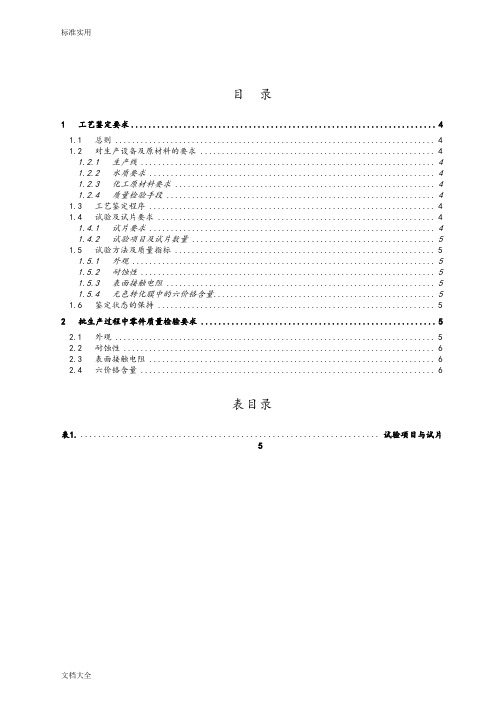
目录1工艺鉴定要求 (4)1.1总则 (4)1.2对生产设备及原材料的要求 (4)1.2.1生产线 (4)1.2.2水质要求 (4)1.2.3化工原材料要求 (4)1.2.4质量检验手段 (4)1.3工艺鉴定程序 (4)1.4试验及试片要求 (4)1.4.1试片要求 (4)1.4.2试验项目及试片数量 (5)1.5试验方法及质量指标 (5)1.5.1外观 (5)1.5.2耐蚀性 (5)1.5.3表面接触电阻 (5)1.5.4无色转化膜中的六价铬含量 (5)1.6鉴定状态的保持 (5)2批生产过程中零件质量检验要求 (5)2.1外观 (5)2.2耐蚀性 (6)2.3表面接触电阻 (6)2.4六价铬含量 (6)表目录表1.................................................................... 试验项目与试片5错误!未找到引用源。
范围:本规范规定了铝及铝合金无色化学转化处理的工艺要求及其质量要求。
本规范适用于铝及铝合金无色化学转化处理的工艺鉴定、首样鉴定和批生产质量检验;可用于指导产品设计、采购和生产,以及用于生产者在零件化学转化处理过程中的质量检验。
供应商来料验收的抽检比例可按其它相关文件执行。
简介:铝合金化学转化处理是一种化学加工工艺,用此工艺所得到的表面膜层可作为有机涂层的底层,也可单独作为防腐蚀层应用。
本规范明确规定了处理工艺为无色化学转化工艺,并制定了此种表面膜层的外观、耐蚀性、表面接触电阻等质量指标,作为华为对生产方进行工艺鉴定和生产者对零件生产质量进行控制的依据。
关键词:铝,化学转化,膜,防腐蚀引用文件:下列文件中的条款通过本规范的引用而成为本规范的条款。
凡是注日期的引用文件,其随后所有的修改单(不包括勘误的内容)或修订版均不适用于本规范,然而,鼓励根据本规范达成协议的各方研究是否可使用这些文件的最新版本。
凡是不注日期的引用文件,其最新版本适用于本规范。
铝阳极氧化MIL-A-8625F标准中文版
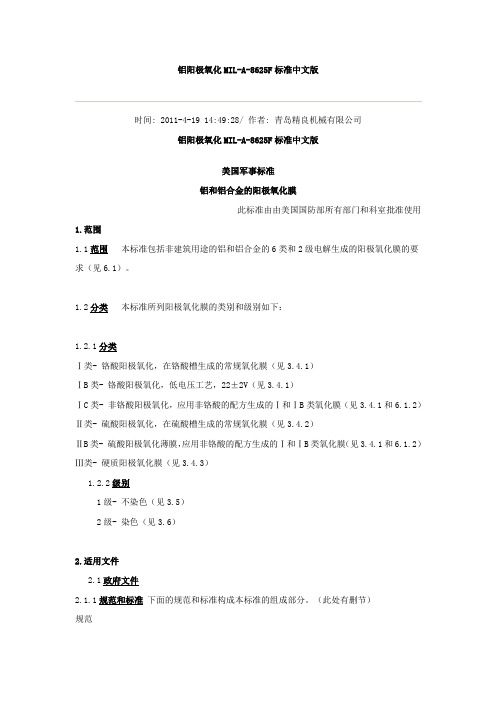
铝阳极氧化MIL-A-8625F标准中文版时间: 2011-4-19 14:49:28/ 作者: 青岛精良机械有限公司铝阳极氧化MIL-A-8625F标准中文版美国军事标准铝和铝合金的阳极氧化膜此标准由由美国国防部所有部门和科室批准使用1.范围1.1范围本标准包括非建筑用途的铝和铝合金的6类和2级电解生成的阳极氧化膜的要求(见6.1)。
1.2分类本标准所列阳极氧化膜的类别和级别如下:1.2.1分类Ⅰ类- 铬酸阳极氧化,在铬酸槽生成的常规氧化膜(见3.4.1)ⅠB类- 铬酸阳极氧化,低电压工艺,22±2V(见3.4.1)ⅠC类- 非铬酸阳极氧化,应用非铬酸的配方生成的Ⅰ和ⅠB类氧化膜(见3.4.1和6.1.2)Ⅱ类- 硫酸阳极氧化,在硫酸槽生成的常规氧化膜(见3.4.2)ⅡB类- 硫酸阳极氧化薄膜,应用非铬酸的配方生成的Ⅰ和ⅠB类氧化膜(见3.4.1和6.1.2)Ⅲ类- 硬质阳极氧化膜(见3.4.3)1.2.2级别1级- 不染色(见3.5)2级- 染色(见3.6)2.适用文件2.1政府文件2.1.1规范和标准下面的规范和标准构成本标准的组成部分。
(此处有删节)规范军事规范MIL-P-23377 耐化学和溶剂腐蚀的环氧聚酰胺涂层,MIL-C-81706 铝和铝合金的化学转化膜MIL-P-85582 水性环氧树脂涂层联邦规范QQ-A-250/4 2024铝合金的板和薄板标准联邦标准FED-STD-141 油漆,清漆,硝基漆和相关材料:取样和测试方法。
FED-STD-151 金属:测试方法军事标准MIL-STD-105 取样程序和质量检查表2.2非政府出版物下面的规范和标准构成本标准的组成部分。
(此处有删节)美国试验和材料学会(ASTM)ASTM B 117 盐雾试验方法ANSI/ASTM B 137 铝和铝合金的阳极氧化膜的重量测试ASTM B 224 利用涡流仪测试铝氧化膜厚度,以及其它非磁性材料上的非导电层的厚度 ASTM D 822 测定油漆,清漆,硝基漆和其它产品的曝光和曝水仪(碳-电弧型)的标准使用方法ASTM D 2244 不透明材料色差的仪器测试ASTM G 23 有水和无水的非金属材料曝光测试的曝光仪(碳-电弧型)的标准使用方法 ASTM G 26 有水和无水的非金属材料曝光测试的曝光仪(氙-电弧型)的标准使用方法2.3优先程序在本标准和所引用的参考文件有矛盾时,本标准具有优先权,但是本标准不能超越现行的相关法律和法规。
国家标准GB_化学转化膜铝及铝合金上漂洗和不漂洗铬酸盐转化膜
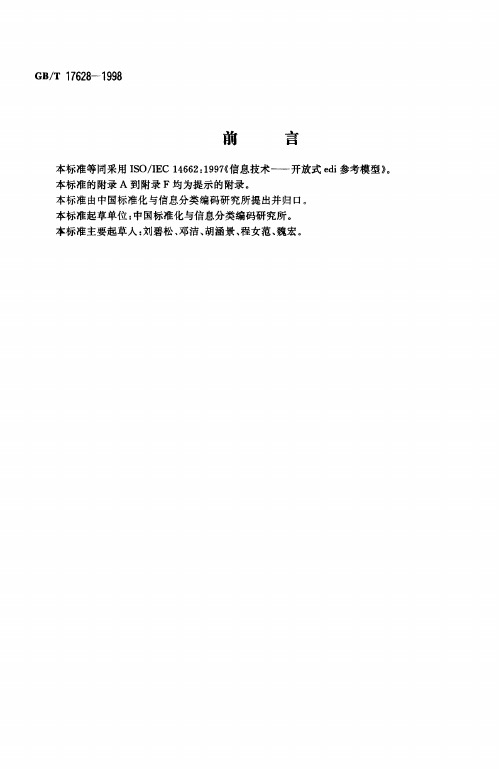
本国 际 标 准由ISO/IEC/JTC1(信 息技术)第 30分委员会(开放式edi)起草。 本 标 准 的附录 A到附录 F为提示的附录。
GB/T 17628-1998
前
台
.二1
本标准等同采用ISO/IEC 14662:1997《信息技术— 开放式edi参考模型》。 本标准的附录 A到附录 F均为提示的附录。 本标准由中国标准化与信息分类编码研究所提出并归口。 本标准起草单位:中国标准化与信息分类编码研究所。 本标准主要起草人 :刘碧松 、邓洁、胡涵景 、程女范 、魏宏 。
开放 式 e di所需的标准覆盖了广泛的领域,它包括但不限于下列几个方面 : — 业 务 方面; — 国 家 和国际法律法规的支持 ; — 信 息 技术通用标准 ,如信息建模标准 ; — 软 件 工程标准; — 数据 建模 标准 ; — 行 业 专用的信息技术标准 ; — 互 连 标准 ,如消息处理、文件传送、交易处理和网络管理 ; — 安 全 标准 。
开 放式 edi参考模 型采用两种视 图来描述 业务交 易的有关方面 : — 业 务 操作视 图(BOV) ; — 功 能 服务视图(FSV), BO V 描 述下列几个方面: a) 业 务 交 易和相关数据交换中的业务数据的语义 ; b) 适 用 于开放式 edi业务需要的业务交易规则,包括 ; — 操 作 约定 ; — 协 定 ; — 相 互 间的义务。 FS V 描述 满足开放式 edi机制要求的支持服务。它重点描述信息技术的下列几个方面: a) 功 能 能力; b) 服 务 接口; 。) 协 议 。 这 些 功 能能力 、服务接 口和协议包括 : — 发起 、运作和跟踪开放式 edi交易进程的能力;
MIL-DTL-5541F_中文版 铝和铝合金的化学转化膜
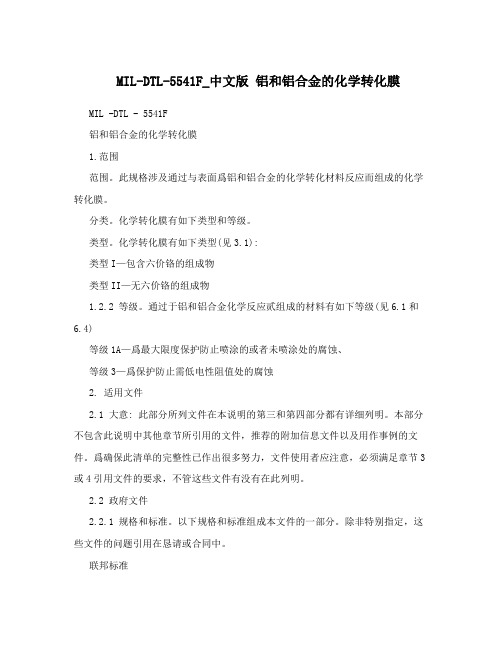
MIL-DTL-5541F_中文版铝和铝合金的化学转化膜MIL -DTL - 5541F铝和铝合金的化学转化膜1.范围范围。
此规格涉及通过与表面爲铝和铝合金的化学转化材料反应而组成的化学转化膜。
分类。
化学转化膜有如下类型和等级。
类型。
化学转化膜有如下类型(见3.1):类型I—包含六价铬的组成物类型II—无六价铬的组成物1.2.2 等级。
通过于铝和铝合金化学反应贰组成的材料有如下等级(见6.1和6.4)等级1A—爲最大限度保护防止喷涂的或者未喷涂处的腐蚀、等级3—爲保护防止需低电性阻值处的腐蚀2. 适用文件2.1 大意: 此部分所列文件在本说明的第三和第四部分都有详细列明。
本部分不包含此说明中其他章节所引用的文件,推荐的附加信息文件以及用作事例的文件。
爲确保此清单的完整性已作出很多努力,文件使用者应注意,必须满足章节3或4引用文件的要求,不管这些文件有没有在此列明。
2.2 政府文件2.2.1 规格和标准。
以下规格和标准组成本文件的一部分。
除非特别指定,这些文件的问题引用在恳请或合同中。
联邦标准FED-STD-141--- 喷涂、油漆、涂漆和其他相关材料:检验、抽验和测试的方法国防部标准MIL-PRF-23377 --- 涂底漆:环氧基树脂,高固形化MIL-DTL-81706--- 用于涂覆铝及铝合金的化学转化膜MIL-PRF-85582--- 涂底漆:环氧基树脂,waterborne或者( 这些文件的副本可以在网站在线查看,或者也可以从位于PA19111-5094费城4D大厦700罗宾逊大街的标准文件预定服务台索取)2.3 非政府出版物。
以下规格和标准组成本文件的一部分。
除非特别指定,这些文件的问题引用在恳请或合同中。
美国材料试验协会ASTM-B117 ---- 盐雾试验仪器操作ASTM-D3359--- 胶带附着力测试( 这些文件副本可以从位于PA19428-2959 ,west conshohocken, ASTM 获得或者从网站了解)美国质量协会(ASQ)ASQ-Z 1.4 --- 通过属性进行程序,抽样及台板检验( 此文件副本可从位于美国密尔沃基市的美国质量协会获得或从网站了解到。
铝及铝合金的 转化
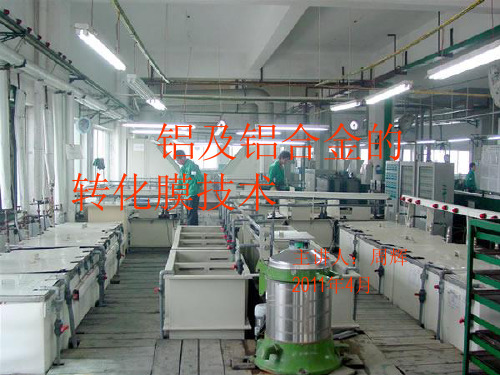
随着氧化时间的延长,氧化膜不断增厚。氧化膜的增 厚实际上是氧化膜的多孔层的增厚。而阻挡层的厚度是取
决于施加电压的恒定值。氧化膜的增厚是膜的生长和膜的
溶解两种作用的结果,即发生在金属/阻挡层的成膜反应 和发生在孔底的膜的溶解作用。阻挡层不断的溶解形成溶 解层,而新的阻挡层又不断产生。氧化膜由外向内生长。
阴极反应:2H++2e-→H2↑ 特点: 氧化反应得到的膜层具有多孔层和阻挡层。 在阳极氧化过程中,即使是施加恒定的电场,但由于 铝金属中的某些杂质及本身结构的缺陷,实际上可以造成 各处电流的不均匀分布,在金属的缺陷处电流较容易通过, 因此电流首先聚集在这里,成为氧化膜生长的核心,并开 始长厚,但达到一定厚度后,膜阻变大,电流很快转移到 阻力较小的薄膜处,因电流比较集中,产生了电场的加速 溶解作用,所以在这里形成了小孔,并迅速转变成扇形状 孔底。
铝及铝合金的 转化膜技术
主讲人:周辉 2011年4月
金属转化膜技术的概述 金属转化膜技术是表面工程技术中的重 要分支之一,在金属的表面中已广泛应用, 例如钢铁的氧化和磷化,铝及铝合金的阳 极氧化等。
•
金属转化膜是指通过化学或电化学方 法,使金属表面形成稳定的化合物薄膜的 技术。 • 转化膜的形成可用下式表示: mM+nAZ- →MmAn+nze式中,M为表层的金属原子; AZ-为介 质中价态为z的阴离子;e为电子。
• 装饰材料的制备过程:
表面 处理
2.6表面处理
• 铝材及制品的表面上都会不同程度地存在着污垢和缺陷。 • 处理过程包括: –脱脂 :除去表面油污赃物 –碱蚀 :进一步清理表面附着的油污赃物;清除制品表 面的自然氧化膜及轻微的划擦伤 –中和:用酸清洗,除去挂灰和残留碱液,以露出光亮基 本金属表面
- 1、下载文档前请自行甄别文档内容的完整性,平台不提供额外的编辑、内容补充、找答案等附加服务。
- 2、"仅部分预览"的文档,不可在线预览部分如存在完整性等问题,可反馈申请退款(可完整预览的文档不适用该条件!)。
- 3、如文档侵犯您的权益,请联系客服反馈,我们会尽快为您处理(人工客服工作时间:9:00-18:30)。
目录1工艺鉴定要求 (4)1.1总则 (4)1.2对生产设备及原材料的要求 (4)1.2.1生产线 (4)1.2.2水质要求 (4)1.2.3化工原材料要求 (4)1.2.4质量检验手段 (4)1.3工艺鉴定程序 (4)1.4试验及试片要求 (4)1.4.1试片要求 (4)1.4.2试验项目及试片数量 (5)1.5试验方法及质量指标 (5)1.5.1外观 (5)1.5.2耐蚀性 (5)1.5.3表面接触电阻 (5)1.5.4无色转化膜中的六价铬含量 (5)1.6鉴定状态的保持 (5)2批生产过程中零件质量检验要求 (5)2.1外观 (5)2.2耐蚀性 (6)2.3表面接触电阻 (6)2.4六价铬含量 (6)表目录表1.................................................................... 试验项目与试片5错误!未找到引用源。
范围:本规范规定了铝及铝合金无色化学转化处理的工艺要求及其质量要求。
本规范适用于铝及铝合金无色化学转化处理的工艺鉴定、首样鉴定和批生产质量检验;可用于指导产品设计、采购和生产,以及用于生产者在零件化学转化处理过程中的质量检验。
供应商来料验收的抽检比例可按其它相关文件执行。
简介:铝合金化学转化处理是一种化学加工工艺,用此工艺所得到的表面膜层可作为有机涂层的底层,也可单独作为防腐蚀层应用。
本规范明确规定了处理工艺为无色化学转化工艺,并制定了此种表面膜层的外观、耐蚀性、表面接触电阻等质量指标,作为华为对生产方进行工艺鉴定和生产者对零件生产质量进行控制的依据。
关键词:铝,化学转化,膜,防腐蚀引用文件:下列文件中的条款通过本规范的引用而成为本规范的条款。
凡是注日期的引用文件,其随后所有的修改单(不包括勘误的内容)或修订版均不适用于本规范,然而,鼓励根据本规范达成协议的各方研究是否可使用这些文件的最新版本。
凡是不注日期的引用文件,其最新版本适用于本规范。
术语和定义1工艺鉴定要求1.1总则生产者的工艺设备、工艺流程、质量保证措施应在其主要的工艺文件中加以说明。
生产者的工艺质量必须满足第 1 节的要求。
1.2对生产设备及原材料的要求1.2.1生产线生产方必须具备半自动、或全自动氧化生产线,不允许用手工线生产。
每个槽位都必须有温度、时间的控制显示器,并在有效校验周期内。
烘干设备能自动控制温度和时间。
1.2.2水质要求所有工艺槽的配制用水必须用去离子水或蒸馏水;化学转化处理前后的清洗用水必须用去离子水或蒸馏水;其它清洗用水必须达到 GB 5749 饮用水要求;清洗槽中水流方式应采用逆流,或者定时更换。
(注:去离子水或蒸馏水的水质要求达到 PH=5.0-7.5,电导率不大于 10 μS/cm)1.2.3化工原材料要求化学转化处理前各工艺槽所用化工原材料必须不低于相应工业级材料的国家标准要求;化学转化及以后所用化工原材料必须不低于相应化学纯级材料的国家标准要求;1.2.4质量检验手段生产方必须具有以下检测仪器:盐雾试验箱、粗糙度检测仪、表面接触电阻测量仪器、以及常规化学分析仪器,并能进行合格的试验操作。
所有检测仪器设备都必须具有有效的校验合格证。
(注:盐雾试验也可委托外部进行,但其试验单位必须得到华为技术有限公司认可并备案)1.3工艺鉴定程序被鉴定的工厂必须完成以下全部试验工作,这些试验必须在零件批生产所用的条件下完成:●试片加工(注1)●表面处理(注2)●试片检查及测试●提供试验报告(注3)及试片给华为技术有限公司以便复验。
注:1.鉴定用试片可由华为技术有限公司完成并提供给被鉴定工厂。
2、所有试片必须同时进行处理。
3、试验报告的发出者必须是华为技术有限公司认可的试验室或机构。
1.4试验及试片要求1.4.1试片要求材料: 6063 裸铝板尺寸: 80×125×1 ~ 4 (mm)表面粗糙度: Ra ≤ 1 m表面处理:无色化学转化;若需要局部氧化时,应在试片的同一面保持一半是阳极氧化膜、一半是化学转化膜。
1.4.2试验项目及试片数量下表给出了工艺鉴定所需的试验项目和试片数量要求:表1.试验项目与试片1.5试验方法及质量指标1.5.1外观所有试片应进行外观检查。
转化膜应是无色透明膜,表现为铝基底颜色;膜层必须连续、均匀、完整,无划伤、污染和腐蚀现象。
要求“光亮”化处理的外观应与 YB015 保持一致。
局部氧化的表面:两种膜层的分界整齐,无溶液渗漏现象,每种膜层外观均符合其对应的质量标准。
1.5.2耐蚀性按 IEC 60068-2-11 进行 100 小时的中性盐雾试验;试验后,在每一试片边缘5mm以外的表面上直径不大于 0.8 mm 的腐蚀点不能多于三个。
1.5.3表面接触电阻按下面所述方法在试片上的化学转化区域测试接触电阻。
利用微欧计,两个电极与被测表面接触,电极面积为 1cm2、电极压强为 1.4MPa(即压力 14kgf),在试样表面上任取两点进行测量,共测五次,其平均值应不大于10mΩ。
1.5.4无色转化膜中的六价铬含量按 ISO3613 中的六价铬存在试验方法检测转化膜中是否存在六价铬。
如果发现存在六价铬,则应利用ISO3613中的比色法定量检测六价铬含量(检测机构必须得到华为技术有限公司认可)。
要求转化膜中的六价铬含量不能高于900ppm。
1.6鉴定状态的保持生产者应保持并遵守经华为技术有限公司正式批准的工艺和检验文件。
经过华为技术有限公司鉴定的工艺,在未得到华为技术有限公司的同意之前,不能改变任何可影响性能质量的工艺参数,否则将重新进行鉴定.。
2批生产过程中零件质量检验要求2.1外观1)所有零件都应进行外观检查。
2)处理后的零件应呈现铝基底颜色;转化膜必须连续、均匀。
完整。
零件表面不允许有划伤、污染、腐蚀痕迹或疏松粉末;但允许有轻微的夹具印。
焊缝及焊点处不允许膜层发黑。
盲孔周围允许有轻微的(孔口半径方向外延不超过2mm)水印痕迹。
3)喷砂表面外观应与标准样板 YB010 一致;拉丝外观应与 YB019 一致。
当有争议时,按 ISO4288 方法测试其粗糙度 Ra 应分别为:喷砂在1.4 ~2.0 µm ;拉丝在1.7~2.7 µm。
4)对局部氧化的零件:阳极氧化膜可以向化学转化膜区域扩展、允许扩展的深度最多2mm;而化学转化膜不能向阳极氧化膜区域扩展;两种膜层的分界线应清晰、整齐,不能呈锯齿状;不能有溶液渗漏现象。
2.2耐蚀性1)耐蚀性检查在与零件同时处理的试片(材料为6063裸铝,尺寸为80×125)或压铸、型材零件上进行。
生产零件为铝板材时用试片,生产零件是型材或压铸件时用零件或零件上的截取部分。
2)试验应在化学转化处理完成 24H 以后、三天之内进行;每生产批至少检查一件3)按 IEC 60068-2-11进行中性盐雾试验:除铝压铸件进行 48 小时的试验外,其它铝零件要求进行100 小时的试验;试验后,在试样距边缘5mm以外的表面上,每 1dm2表面上的腐蚀点不能多于 3个、直径不大于 0.8 mm。
零件上的孔周边作为边缘对待。
4)当生产的零件尺寸太大(不能放入试验箱)时,可以用该零件上的典型结构部分作替代试样。
5)对于化学转化处理后进行了局部喷涂处理的零件,不要求检测耐蚀性。
6)对于化学转化后只进行丝印、不再进行其它处理的零件,耐蚀性要求与上面第3)点一致。
2.3表面接触电阻1)检测在零件上的无色化学转化处理区域进行。
2)每生产批零件至少检查一件。
按 1.5.3 节的描述进行检测,要求零件上任意两点间的电阻不大于 20 mΩ。
3)若零件面积小于 1cm2,允许用常规万用表的“声音”档进行检测,即将其测量电极平放、与零件表面接触,施以轻压(小于140g),当有蜂鸣声(显示导电)时则认为合格。
2.4六价铬含量1)属于华为指定的氧化加工商,由氧化者每年提供一次零件上的膜层环保检测报告;检测单位必须是华为认可的机构。
2)其它氧化商按以下要求进行试验测试:3)每周试验一次,有新调整化学转化处理溶液后也必须试验一次。
试验样件必须从批生产零件中抽取至少一件。
检测在零件上的无色化学转化处理区域进行。
4)按 ISO3613 中的六价铬存在试验方法检测钝化膜中是否存在六价铬。
5)如果发现存在六价铬,则应利用ISO3613中的比色法定量检测六价铬含量(检测机构必须得到华为技术有限公司认可)。
要求转化膜中的六价铬含量不能高于900ppm。
TABLE OF CONTENTS1.REQUIREMENTS FOR PROCESS AUTHENTICATION (10)1.1.G ENERAL R EQUIREMENTS (10)1.2.R EQUIREMENTS FOR P RODUCTION E QUIPMENT AND M ATERIALS (10)1.2.1.Production Line (10)1.2.2.Requirements for Water Quality (10)1.2.3.Requirements for Chemical Materials (10)1.2.4.Quality Control Method (10)1.3.P ROCESS A UTHENTICATION P ROCEDURE (11)1.4.R EQUIREMENTS FOR T ESTS AND T EST P IECES (11)1.4.1.Requirements for Test Pieces (11)1.4.2.Test Items and Piece Quantities (11)1.5.T EST M ETHOD AND Q UALITY I NDEXES (12)1.5.1.Appearance (12)1.5.2.Corrosion Resistance (12)1.5.3.Surface Contact Resistance (12)1.5.4.Chromium (VI) Content in Colorless Conversion Films (12)1.6.K EEPING OF A UTHENTICATION S TATUS (12)2.QUALITY CONTROL OF BATCH PRODUCTION (13)2.1.A PPEARANCE (13)2.2.C ORROSION R ESISTANCE (13)2.3.S URFACE C ONTACT R ESISTANCE (14)2.4.C HROMIUM (VI)C ONTENT (14)3.REFERENCES (14)LIST OF TABLESTABLE 1 TEST ITEMS AND NUMBER OF TEST SPECIMENS (11)错误!未找到引用源。
